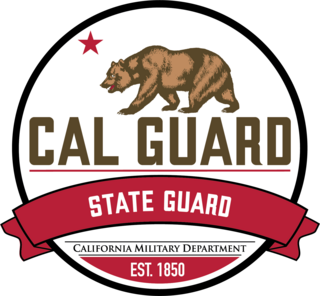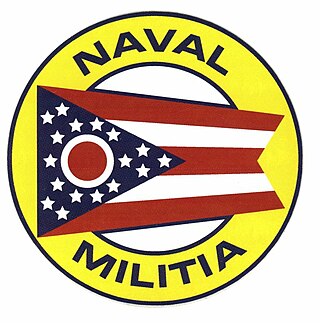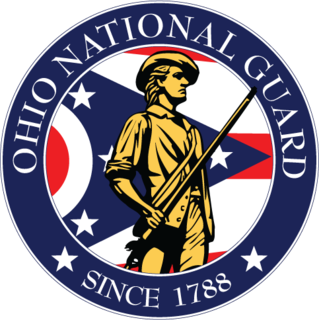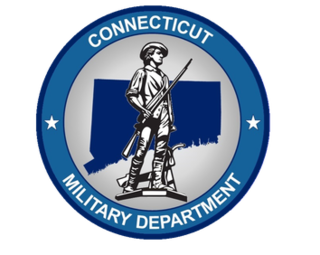
In the United States, state defense forces are military units that operate under the sole authority of a state government. State defense forces are authorized by state and federal law and are under the command of the governor of each state.

The California State Guard (CSG) is a component of the California National Guard (CNG). The CSG is a volunteer force that supports the state missions and federal readiness of the Army and Air National Guard. CSG service members come from all branches of the military and are citizens with essential skills. Many CSG service members are fully integrated with Army National Guard and Air National Guard units, and are full-time state active duty.

The Ohio Naval Militia is the naval militia of the State of Ohio. It is the naval arm of the State of Ohio's Adjutant General's Department, and is part of Ohio's military forces.

The Virginia Defense Force (VDF) is the official state defense force of Virginia, one of the three components of Virginia's state military along with the Virginia National Guard which includes the Virginia Army National Guard, the Virginia Air National Guard, and the unorganized militia. As of 2019, the VDF has approximately 250 soldiers. The VDF is the descendant of the Virginia State Guard, the Virginia Regiment, and ultimately the Colonial Virginia militia of the Virginia Colony.

The New York State Division of Military and Naval Affairs is responsible for the state's New York Army National Guard, New York Air National Guard, New York Guard and the New York Naval Militia. It is headed by Adjutant General of New York Major General Raymond F. Shields Jr., appointed on October 1, 2018. with the Governor of New York Kathy Hochul serving as Commander in Chief of the state's militia forces. It is part of the New York State Executive Department.

The Georgia State Defense Force is a professionally trained, volunteer component of the Georgia Department of Defense, serving in support of the national and state constitutions under direction of the governor and the adjutant general of Georgia. As a State Defense Force (SDF), the GSDF serves alongside the Georgia Army National Guard and the Georgia Air National Guard.
Awards and decorations of the state defense forces are presented to members of the state defense forces in addition to regular United States military decorations and state National Guard military decorations. Each of the state governments of the United States maintains a series of decorations for issuance to members of the state defense forces, with such awards presented under the authority of the various state adjutants general and/or respective state defense force commanders.

The Ohio National Guard comprises the Ohio Army National Guard and the Ohio Air National Guard. The commander-in-chief of the Ohio Army National Guard is the governor of the U.S. state of Ohio. If the Ohio Army National Guard is called to federal service, then the President of the United States becomes the commander-in-chief. The military commander of all forces in the State of Ohio is the Adjutant General, Major General John C. Harris, Jr. is responsible for the command of 17,000 members, preparedness and readiness, installation management, and budget of the Ohio National Guard. The current Assistant Adjutant General for Army, with responsibility for overseeing the Ohio Army National Guard training and operations, is Brigadier General Thomas E. Moore II. The current Assistant Adjutant General for Air is Major General James R. Camp with responsibility for overseeing the Ohio Air National Guard.

The Connecticut Military Department is a state agency of the government of Connecticut. Its primary components are the Connecticut Army National Guard, the Connecticut Air National Guard, and four companies of the state militia. The Military Department of the State of Connecticut traces its origins to May 11, 1637, when the "General Courts" established a military arm of the provincial government. In 1939, the State's Military Department was established to consolidate the offices of Adjutant General, Quartermaster General, Armory Board, and Armory Board Inspector.

The Texas State Guard (TXSG) is part of the state military force of Texas, and one of three branches of the Texas Military Forces. Along with the other two branches, the TXSG falls under the command of the Governor of Texas and is administered by the Adjutant General of Texas, an appointee of the Governor. The other two branches of the Texas Military Forces are the Texas Army National Guard and the Texas Air National Guard.

The Uniformed Services Employment and Reemployment Rights Act of 1994 was passed by U.S. Congress and signed into law by U.S. President Bill Clinton on October 13, 1994 to protect the civilian employment of active and reserve military personnel in the United States called to active duty. The law applies to all United States uniformed services and their respective reserve components.

The Mississippi State Guard (MSSG) is the state defense force of Mississippi. It operates under the authority of the Mississippi Military Department alongside the Mississippi Army National Guard (MSARNG) and the Mississippi Air National Guard (MSANG).

The Indiana Guard Reserve (INGR), formerly the Liberty Guard and the Indiana Legion, is the state defense force of the state of Indiana. The Indiana Guard Reserve serves under the exclusive authority of the governor of the State of Indiana through his executive agent for military matters, The Adjutant General of Indiana. The Guard Reserve is a unique military organization designed to supplement the Indiana National Guard and to defend Indiana if any part of the Indiana National Guard is in active federal service. The Indiana Guard Reserve also provides MEMS qualified soldiers who can augment Indiana Homeland Security missions and County Emergency Operations activities.

The Massachusetts State Defense Force (MSDF) was a state defense force of the Commonwealth of Massachusetts. It was inactivated in 2016 by Governor Charlie Baker. The purpose of the Massachusetts State Defense Force was to augment the Massachusetts National Guard during emergencies in the state, especially when some or all of the National Guard was deployed. The MSDF was an all-volunteer militia which reported to the State Adjutant General and was under the command of the Governor of Massachusetts. Members met for drills one weekend per month unless activated by the Governor during an emergency. The MSDF was headquartered at Milford, Massachusetts, in the same building as the Massachusetts National Guard. The director of the MSDF was appointed by The Adjutant General of Massachusetts (TAGMA). The Massachusetts State Defense Force was authorized by both the Constitution of Massachusetts and chapter 33 § 10 of the Massachusetts General Laws.

The South Carolina State Guard (SCSG) is the designated state defense force for the state of South Carolina.

The New Mexico State Defense Force (NMSDF), formerly known as the New Mexico State Guard (NMSG), is the state defense force of the state of New Mexico. The NMSDF is an all-volunteer, reserve military force which works in parallel to the state's National Guard. It is authorized by Title 32, Section 109, United States Code, NGB Reg. 10-4, Chapter 20, NMSA, 1978 Comp., the U.S. Constitution, and the New Mexico State Constitution.

The Puerto Rico State Guard (PRSG) —Spanish: Guardia Estatal de Puerto Rico— is the state defense force of Puerto Rico that operates under the sole authority of the governor of Puerto Rico who, in turn, delegates such authority to the Puerto Rico Adjutant General. The Guard's secondary purpose is to assume the state mission of the Puerto Rico National Guard in the event that the National Guard is mobilized. The first incarnation of the PRSG was created in 1941 in response to World War II and it disbanded in 1946. The PRSG was revived in 1971 and has remained in continuous existence since then. The PRSG is one of the few state defense forces of the United States that has an air division.

Employer Support of the Guard and Reserve (ESGR) is the lead U.S. Defense Department program promoting cooperation and understanding between civilian employers and their National Guard and Reserve employees. Established in 1972, ESGR operates within the Office of the Assistant Secretary of Defense for Reserve Affairs. ESGR develops and promotes supportive work environments for service members in the Reserve Components through outreach, recognition, and educational opportunities that increase awareness of applicable laws and resolves employer conflicts between the service members and their employers.

The Missouri State Defense Force (MSDF), formerly known as the Missouri Reserve Military Force, was the official state defense force of Missouri, deactivated in 2022. As a state defense force, the MSDF was a reserve military force which served parallel to the Missouri National Guard. As the MSDF fell solely under the command of the state of Missouri, it could not be federalized or deployed outside the borders of Missouri, unlike the National Guard. Although the MSDF and the Missouri National Guard were separate organizations, the MSDF's primary scope was to work alongside the National Guard during stateside operations, or in lieu of the National Guard when the National Guard is deployed outside of Missouri. Along with the Missouri Army National Guard, the Missouri Air National Guard, and the Missouri Naval Militia, the Missouri State Defense Force is recognized under Missouri law as part of the organized militia of Missouri.




















